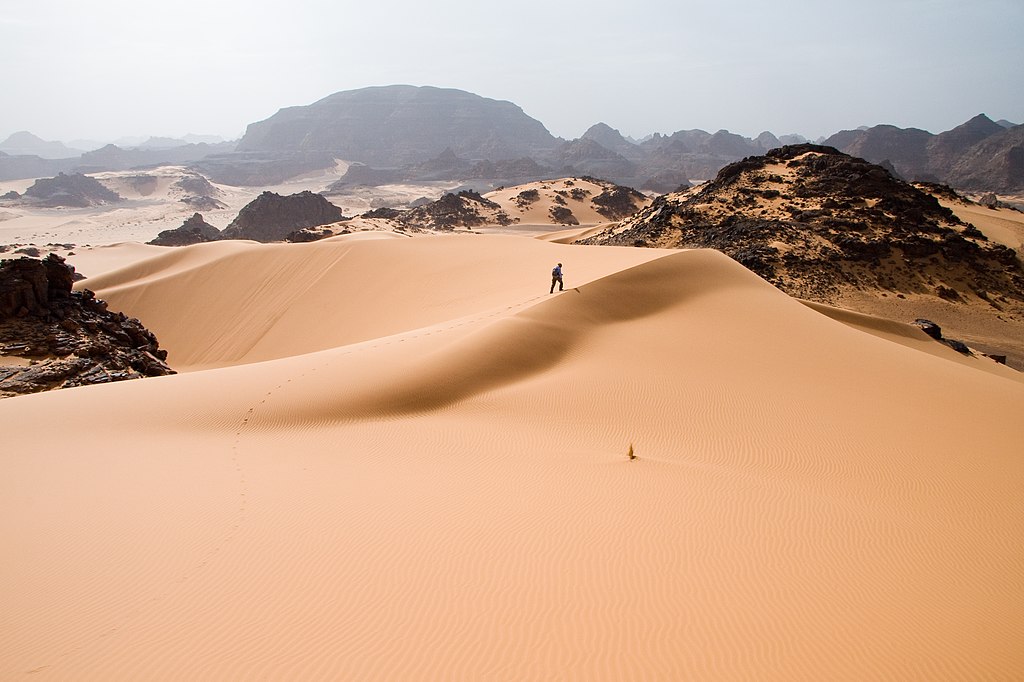The Sahara Desert occupies 30% of the area of Africa. It is the largest of all the hot deserts on Earth, it covers an area of 8.6 million km2, exceeding in this indicator all countries of the world, except Russia, Canada, China, and the United States. It is slightly larger than Brazil, less than a hundred thousand square kilometers. Let’s get acquainted with interesting facts about the amazing and mysterious facts about the Sahara desert.

Where is the Sahara Desert located on a world map?
1. The Sahara desert exactly located in Northern Africa covering Algeria, Chad, Egypt, Eritrea, Morocco, Niger, Sudan, Tunisia, Libya, Mali, Mauritania as borders.
2. The territory occupied by the Sahara could accommodate the whole of Australia, which is generally a separate continent, and there would still be room for Finland and Norway.
3. There is one dessert on Earth that is larger than the Sahara – the Antarctic Desert. As its name implies, it is located in Antarctica, and even in summer, the temperature does not rise above -20C.
4. The Sahara Desert is slowly but steadily growing, growing by hundreds of square kilometers each year. It is gradually moving south, capturing more and more territories, and its southern border is moving 5-10 kilometers per year.
5. The average height of the dunes in the great desert often exceeds 150 meters, which is comparable to the height of a skyscraper building in 30-40 floors. And individual dunes sometimes have more than 300 meters in height! For comparison, the height of the Eiffel Tower in Paris is 324 meters.
6. Life here is incredibly difficult due to the climatic conditions and lack of water. However, about 2.5 million people live on the territory of the Sahara! Huge areas here remain uninhabited, settlements arise only around oases, where there is enough water and vegetation for cattle breeding.
7. Scientists have found that in the distant past, there were forests on the site of the Sahara, there were rivers and lakes, but then the climate in Africa began to change. This process began about 5 million years ago and finally ended about 10 thousand years ago.
8. Today, there are only two large lakes and one river on the territory of the Sahara. Lake Unianga (more precisely, it is a complex of lakes) and Chad serve as a source of water for a fair part of the local population, and the only river flowing through the great desert is the Nile.
9. Sometimes it rains here, and more often than, for example, in the Atacama desert, in South America – in some parts of it, there has been no rain for more than 400 years.
10. Heavy rains in the Sahara occur once every few years, but most often the rains here simply do not reach the surface of the earth, evaporating in the hot air.
11. During the day, the air temperature here can easily rise to +50 °C, and the top layer of sand is heated to +70-80 °C. Without special shoes in such conditions, you can not walk on the sand, this is fraught with severe burns.
12. Due to daily temperature fluctuations, it is very cold at night in the Sahara. As soon as the sun goes down, the temperature drops sharply by tens of degrees, and sometimes in the morning, even frost falls on the dunes.
13. In the Sahara, there are mountains, sometimes quite high, under two kilometers high. There, the temperature at night can generally drop to -15 -17 °C!
14. Despite such a harsh climate, the diversity of life in the Sahara is quite large. There are about 4,000 different species of animals, and most of them are nocturnal, waiting out the heat of the day in shelters.
Do people live in the Sahara Desert?
15. The answer is Yes, Around 25 million people live in the Sahara desert. Most of the people are experienced with desert nature.
16. In the Sahara desert, mirages killed many travelers. Because of them, you can sometimes see an oasis with trees on the horizon, although it will be hundreds of kilometers away from there.
17. There are very rich deposits of oil and natural gas in the Sahara. The largest of them is the Hassi-Mesaud field, owned by Algeria, with oil reserves estimated at 2.4 billion tons.
18. The roots of many native plants go deep into the soil for 15-20 meters. This allows them not only to reach underground waters but also to resist the onslaught of ferocious sandstorms.
19. Interesting fact: not all of the Sahara is a vast sea of sand. There are no fewer rocky areas here, and there are no dunes on them because the sand is blown away by the wind.
What lives in the Sahara?
20. There are about 500 different types of plants growing here. Many of them remain in a state of suspended animation for years, but after the first heavy rain, they quickly bloom.
21. There are quite a few oases here, and no one has ever tried to calculate the exact number of them. They occur where the waters of underground rivers break through to the surface, but nothing lasts forever, including oases.
22. Sandstorms originating in the great desert have great destructive power. Sometimes they can rage for several days while bringing sand to the oases and settlements located around them.
23. In most parts of the Sahara, dew falls in the morning, and it is quite abundant. Local plants and animals have adapted to use this water, and it is quite enough for them.

